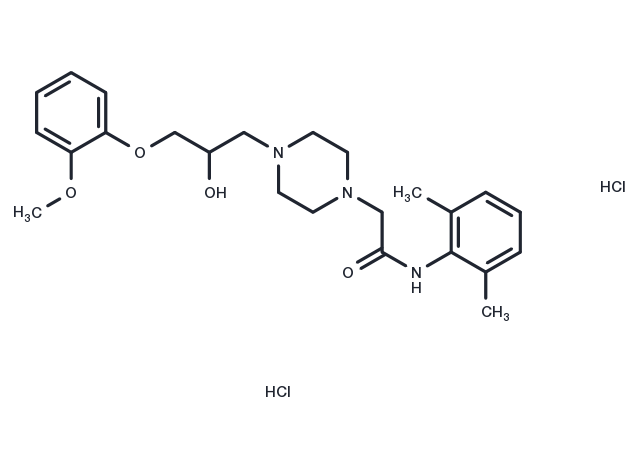Powder: -20°C for 3 years | In solvent: -80°C for 1 year


Ranolazine dihydrochloride (Ranolazine 2HCl) , an antianginal agent, can treat arrhythmia via a novel mechanism of action (inhibition of the late phase of the inward sodium current), and do not affect blood pressure or heart rate.

| Pack Size | Availability | Price/USD | Quantity |
|---|---|---|---|
| 50 mg | In stock | $ 44.00 | |
| 100 mg | In stock | $ 62.00 | |
| 200 mg | In stock | $ 97.00 | |
| 500 mg | In stock | $ 158.00 | |
| 1 g | In stock | $ 217.00 | |
| 1 mL * 10 mM (in DMSO) | In stock | $ 63.00 |





| Description | Ranolazine dihydrochloride (Ranolazine 2HCl) , an antianginal agent, can treat arrhythmia via a novel mechanism of action (inhibition of the late phase of the inward sodium current), and do not affect blood pressure or heart rate. |
| Targets&IC50 | INa:6 μM (IC50), IKr:12 μM (IC50) |
| Synonyms | RS 43285, Ranolazine 2HCl |
| Molecular Weight | 500.46 |
| Formula | C24H35Cl2N3O4 |
| CAS No. | 95635-56-6 |
Powder: -20°C for 3 years | In solvent: -80°C for 1 year
DMSO: 50.1 mg/mL (100 mM)
H2O: 50.1 mg/mL (100 mM)
You can also refer to dose conversion for different animals. More
bottom
Please see Inhibitor Handling Instructions for more frequently ask questions. Topics include: how to prepare stock solutions, how to store products, and cautions on cell-based assays & animal experiments, etc.
Ranolazine dihydrochloride 95635-56-6 Autophagy Membrane transporter/Ion channel Metabolism Calcium Channel Sodium Channel Ranolazine Dihydrochloride RS43285 RS-43285 RS 43285 CVT-303 Inhibitor Ranolazine inhibit Ca2+ channels CVT303 Na+ channels Ranolazine 2HCl Ca channels Na channels CVT 303 inhibitor
